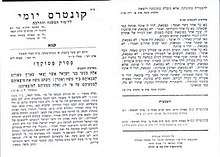Pinchas Kehati
Pinchas Kehati, born Pinchas Guchtman,[1] (1910 – December 21, 1976) was the author of משניות מבוארות Mishnayot Mevuarot (literally "Explained Mishnayos", popularly known as "the Kehati Mishnayot") which is a commentary and elucidation on the entire Mishnah. This work was written in Modern Hebrew. This work was translated into English and published in 1994 as The Mishnah.
Biography
Kehati was born in Volhynia, Poland.[2] In his youth he studied in religious and religious Zionist schools.[1] He received rabbinical ordination from the rabbinical school in Warsaw.[2] He made aliyah in 1935. He began studies at Hebrew University but was forced to abandon them due to financial difficulties. He initially worked as a teacher and with HaPoel HaMizrachi. Later, for many years, he worked as a teller in Bank Mizrachi.[1]
As part of his involvement with HaPoel HaMizrachi, in 1953 he began to lead its Youth Department. He had the idea to publish a daily pamphlet with commentary on the day's Mishna being studied as part of the Mishna Yomit cycle (two mishnayot per day). He originally asked several other people to write the commentary, but was dissatisfied with the results. On his wife's suggestion, Kehati began to write the commentary himself.[1]
The commentary was printed beginning in early 1955.[1] Initially a single page was printed each day, covering two mishnayot. Later, the format switched to a weekly pamphlet covering 14 mishnayot.[2] Initially, Kehati bore all the costs with no external funding. However, after eight months this became overwhelming and he was forced to stop. Soon external donors appeared to support the project. Work resumed, and the commentary to the entire Mishna was finished in 1963.[1]
On the encouragement of the Lubavitcher Rebbe, he began to produce a similar commentary on the Torah, but this did not succeed.[2]
Kehati also composed tunes for traditional Jewish songs. He died in 1976.[2]
Commentary
In the wake of the Holocaust, many religious Israelis began to study Mishna in memory of the souls of loved ones.[3] In response to the growing demand for a commentary of the Mishna in Modern Hebrew, Kehati was sponsored by the B'nei Akiva of B'nei Berak to develop a commentary. Kehati wanted to spread Torah throughout the world, so he sought to write a clear, concise, and easy-to-read commentary and elucidation on the entire Mishnah.

Between 1955 and 1964, Kehati published a weekly pamphlet which was hand-delivered to 5,000 subscribers. In each pamphlet, he explicated 14 Mishnayot (two per day), two laws from the Shulchan Aruch, two laws from the Rambam, and a selection from Tanakh. The first pamphlets contained commentaries that Kehati compiled from local yeshiva students. Frustrated at the inconsistencies in the commentary quality and approach, Kehati hired Rabbi Zvi A. Yehuda, who taught Mishna on an Israel Broadcasting Service (Kol Israel) radio program, to help develop a consistent approach to his commentary.[4] Between 1956 and 1959, approximately 150 of pamphlets included attribution to his co-author. The first book-edition of the Kehati Mishna includes this attribution (see image). Many editions have since been published after Kehati's death in 1976. Recent editions include the traditional Bartenura commentary, improving its appeal to the Haredi community. Even though Kehati was a Religious Zionist, his works can be found in many Haredi homes and synagogues.
Comparison to other commentaries
Kehati's Mishna was written in Modern Hebrew, the book cover design used a modish font and color, and it lacked decorative edge-marbling. The page layout of the Kehati commentary mimics the layout found in Dr. Symcha Petrushka's Yiddish commentary of the Mishnayot (published in Montreal, 1946). Both Kehati and Petrushka were raised in Warsaw. Kehati's commentary was influenced by the clarity of the Meiri's Talmud commentary, as well as the modern approaches of Dr. Petrushka, Rabbi Zvi A. Yehuda, and Professor Hanoch Albeck whom he quotes in his commentary.
External links and References
- Retrospective on the 30th year since his passing (Hebrew), kipa.co.il
- Kehati commentary (translation) at the Wayback Machine (archived June 25, 2003). Published online as part of a study program of two Mishnayot per day. Currently inactive, but archives contain the complete text of Kehati in English for Moed, Nashim, Nezikin, and about half of Kodashim.
Notes
- Commentaries on the Mishna from the 20th Century, Part 2, Yosef Marcus
- Rabbi Pinchas Kehati (Hebrew), tog.co.il
- The Hebrew letters for Mishna (משנה) is an anagram for the Hebrew word Neshama (spirit/soul) (נשמה), and thus the study of Mishna in memory of (and according to many, to provide spiritual benefit to) the departed is a well-known custom.
- https://www.clevelandjewishnews.com/community/lifecycles/obituaries/yehuda-rabbi-zvi/article_d45ca9b4-547c-11e4-89f9-9771a51b0800.html